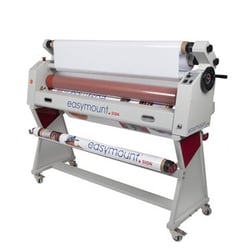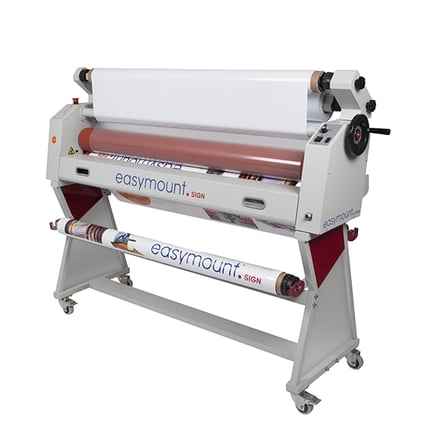Similar Posts
8 Mar 2017
Lamination, what is it and how does it apply to your business?

There are lots of laminators on the market. Whether you want to simply laminate a menu for your restaurant or create awe inspiring wedding invitations, laminators now offer a fantastic versatility and in some cases offer a whole new revenue stream to your business. Today, I’ll explain what lamination does, what each of the terms in lamination mean, applications to lamination and why laminate.
What is lamination?
At it’s most basic, lamination protects and enhances a graphic. Different films can be used to create very distinctive finishes that add some flair and professionalism to the finished product. Printed vinyl for signage or vehicle wraps are afforded extra protection when handled thanks to lamination, which can be especially important for products such as roller and pop-up banners that are handled excessively around the time of an event.
Do you Laminate, Encapsulate or Mount?
Lamination is usually applied on 1 side only with a pressure sensitive over laminate film. These films give a quality finish. Good quality pressure sensitive over-laminate film is usually between 50 and 100 micron in thickness. Encapsulating involves a heat activated thermal film being applied on both sides of the print. The finished result is trimmed to leave a clear border around the edge of the print, therefore encapsulated. Film is available in gloss and matt finishes in a range of thickness including 38, 75, 125 and 250 micron rolls. Mounting fixes a print to a substrate/board using an adhesive. This can be permanent or semi-permanent.
Hot or Cold, how do you like your laminate?
There are just 3 options:
1. Cold
2. Heat-Assist (usually 60°C)
3. Hot (up to 130°C) – For Encapsulation

Cold Lamination is required for Vehicle Wraps. Pressure Sensitive Laminating Film can be applied either cold or with heat-assist (usually about 40-50°C) to soften the adhesive. This allows it to flow into the print better and to help eliminate a ‘silvering’ effect that can occur when laminating cold. Silvering refers to the bubbles or ‘spots’ that can appear under a lamination film, an effect that is not usually permanent. It can be greatly reduced with heat-assisted lamination, but the effect will improve slightly over a 24-48 hour period even if no heat has been used.
Why you should laminate and when?
Lamination protects against marking and damage and enhances almost any type of printed material by deepening and brightening colours and contrast. As some inks fade over time, laminates that include UV qualities are recommended for signs that will be used outdoors. Laminating a print is an easy way to provide the end-user with added value. By laminating a customer’s product, you are giving them a higher quality product with a professional finish. Lamination can improve their overall business image, which helps them to bring in more sales. It also saves the customer money in the long-term, as the finished product can be reused without getting scratched or torn. Valuable graphics are protected, signs and posters are given extra strength and low-cost weather resistant signage can be produced.
Types of Vinyl and Laminate available
Monomeric Calendered, Polymeric Calendered and Cast Laminates are also available, ideally matched to your vinyl, e.g. Cast Film + Cast Laminate. The laminate is available in many finishes; Gloss, Crystal, Sandtex, Lustre Matt, Flat Matt, Dry Wipe & Anti-Graffiti.
What are the applications of wide format laminators?
- Vehicle Wraps
- Roller Banners, Pop-up Displays & Exhibition Graphics
- Floor Graphics
- Outdoor Signage
- Posters, Graphics & Signs
- Mounting Prints to Boards and other substrates such as Aluminium DiBond
- Applying Application Tapes
- Flood Coating Boards with Coloured Vinyl
- Many other bespoke applications in other
markets such as packaging
Which laminator is best for wide format?
If you are looking for a laminator which is built to last, cost effective and designed to laminate, mount and encapsulate, you cannot go too far wrong with the Easymount Wide format 1,400 or 1,600 systems. The 1,400 has a max width of 1420mm while the 1,600 stretches to 1,620 mm. These laminators are designed to handle most jobs that are thrown at them and are extremely user-friendly to use.

There are many features and benefits when using a high-quality Easymount laminator, including:
- Convex Rollers – uses the full width of the roller without any creasing or bubbles
- Rollers can be taken up to 28mm height, ideal for Corex or MDF.
- Swing-out feed tray gives complete access to rollers when loading film and vinyl
- Tensioners are on the film, rather than on the system, meaning that nothing wears.
- Film loading on the rear coats the bottom roller
- Film is locked in place, meaning no drift
- Optional take-up unit for reel-to-reel lamination, even 100m lengths
- Fast at up to 6m a minute
- Media Bar keeps prints flat when feeding in
- Time and cost saving – laminate in-house
- 1st Class install, service and back-up in the DBC Group in Ireland
If you are interested in getting a free demonstration of the Easymount Laminator, click here and fill in your details and a member of our team will be in touch with you.